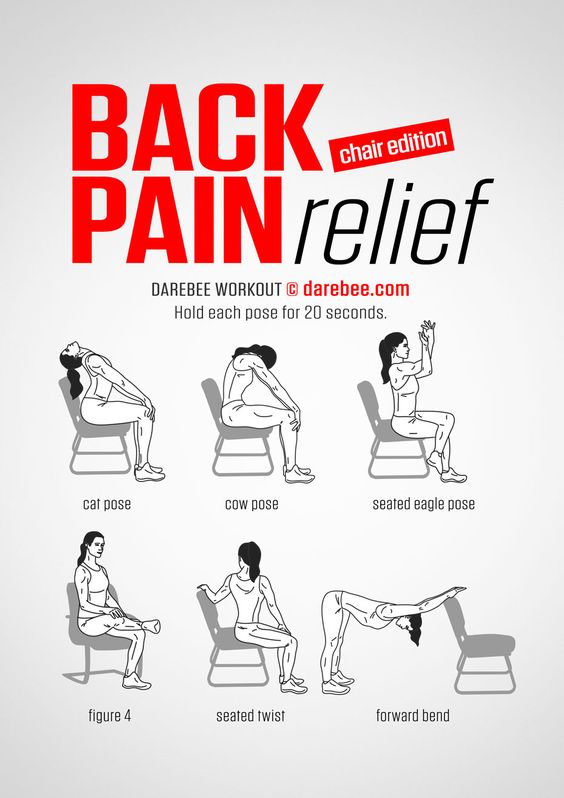
How to Deal With Your Aching Back : Having an aching back is no fun at all. And it doesn’t help to know that 80 percent of adults experience it at one time or another. Lower back pain is just about the most common cause of job-related disability and missed work days, not to mention that it can stop you from doing all the things you enjoy.
It’s a bit perverse that most back pain can come from doing too much or from doing too little. But regardless of whether your back hurts because you were too energetic in spin class or helping your bestie move, or whether it hurts because you sit at a desk all day and curl up into the couch watching Netflix all night, you want to be done with it.
So what causes back pain, and how should you treat it?
What’s Going on Back There
Running down your back is the vertebral column that houses and protects your nerve-filled spinal cord and provides the main support for your body. It’s casually known as the backbone, but it’s actually made up of 33 bones called vertebrae that stack on top of each other and interlock. Between the vertebrae are discs of cartilage which act as cushiony shock absorbers for them.
There are three main muscle groups that affect the spine and back. The extensors are attached to the back of the spine and enable us to stand and to lift objects. The flexors include the abdominals and are in the front, enabling us to flex and bend forward. The obliques are attached to the sides of the spine, and they allow us to rotate and twist.
Ligaments and tendons are another important part of the picture. Ligaments are strong bands of fibrous tissue that hold the vertebrae together, stabilize the spine and protect the discs. Tendons are the fibrous tissue that connect the muscles to the bones.
Causes and Symptoms of Back Pain
In most cases, back pain is caused by everyday stuff. The muscles of your back might feel tight and painful if you’ve strained your back twisting it into an extreme position in a yoga class or while trying to reach an electrical outlet behind the couch. Or you might have strained your muscles by lifting something heavy straight up from the floor without bending your knees or hinging your hips properly.
It can also be caused by simply sitting too long in one position or even by prolonged periods of emotional tension. But here are some of the more serious causes:
- Slipped disc. Trauma or repetitive stress on the spine, significant weight gain and even the natural process of aging can all be contributing factors to deterioration of the discs. Without treatment, a bulging disc (commonly called a slipped disc) can tear. When that happens, it’s called a ruptured or herniated disc. Symptoms include sharp pain that may move down into the derrière, groin and/or down one leg. A disc may also cause muscle weakness, tingling and numbness.
- Spine osteoarthritis. Wear and tear of the cartilage in the spine makes the joints begin rubbing against each other, causing a limited range of motion and throbbing pain that’s worse when you move. With time, the body generates new bony growths (bone spurs) to stabilize the joints, and these can eventually compress adjacent nerve roots and cause numbness and tingling. Left untreated, osteoarthritis can progress into spinal stenosis, a narrowing of the spinal column.
- Aging can cause a significant loss of bone density, particularly for women. As bones become more brittle, the vertebrae may develop tiny fractures and start to collapse, putting pressure on the spinal discs and nerves and causing sudden, severe back pain that gets worse as you stand or walk.
How to Deal With Back Pain
Back pain treatment options vary with the cause. For the occasional pain that many of us feel when we’ve overdone it in one way or another, the symptoms often disappear within a few days or weeks with no treatment at all. If symptoms persist, it’s time to see a professional and have the problem diagnosed and treated.
- Medication doesn’t cure back pain, but relieving that pain in the short term makes it more tolerable while you recover.
- Physical therapy. Exercises to strengthen your back and core muscles will help you get stronger and improve your range of motion.
- Interventional treatments. Sometimes injections, electrical stimulation or other procedures will bring relief.
- Some back problems require surgery, but today’s advances allow many patients to have surgery on an outpatient basis and even without general anesthesia. These minimally invasive procedures can deliver positive results with faster recovery times.
Related Videos about How to Deal With Your Aching Back:
60-Second Back Pain Fixes
3 Exercises to Help Relieve Back Pain
Back Pain Management: Treatment of Chronic Back Pain | UCLA Health
Lower Back Pain: Don’t Lie Down
Lower Back Pain Stretching Routine. Free Online Pain Relief Video.
Exercises to Help With Lower Back Pain. Free Online Injury Prevention Routine.
Related Infographics about How to Deal With Your Aching Back:
 100vw, 2078px”><figcaption class=) Yoga Flow for Lower Back Pain
Yoga Flow for Lower Back Pain
 100vw, 564px”><figcaption class=) Stretches to keep your back happy
Stretches to keep your back happyHow to Deal With Your Aching Back
how to relieve back pain at home, how to relieve back pain fast, natural remedies for back pain and inflammation, lower back pain relief products, severe lower back pain, chronic back pain treatment, upper back pain, how to make your back hurt less, Deal With Your Aching Back
